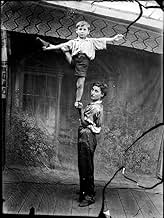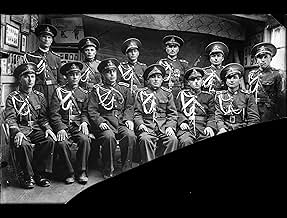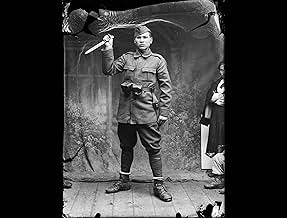A film constructed using the opposition of what a huge collection of recently discovered glass-plate photographs from the 30's and 40's tell us about Romania and what they do not show.A film constructed using the opposition of what a huge collection of recently discovered glass-plate photographs from the 30's and 40's tell us about Romania and what they do not show.A film constructed using the opposition of what a huge collection of recently discovered glass-plate photographs from the 30's and 40's tell us about Romania and what they do not show.
- Director
- Writers
- Star
- Awards
- 1 win & 5 nominations total
- Director
- Writers
- All cast & crew
- Production, box office & more at IMDbPro
Storyline
Featured review
It so happens (and maybe it was not just a coincidence) that I have seen 'The Dead Nation' ('Tara moarta' in Romanian) at the Haifa International Film Festival the very day that is declared in Romania as the National Holocaust Day. I saw the film in a hall where maybe one half of the viewers were survivors of the Holocaust or their immediate descendants. This very special documentary created by Radu Jude is part of a still open debate in Romania about the role and responsibility of its leaders and people in the Holocaust. It's the kind of event that cannot be judged only from the perspective of the film fan, because it includes so much history, politics and emotional charge.
Radu Jude shows again that he is a director who does not run away from controversy and who is not afraid of inventing new ways to put on screen his ideas and the messages that he considers as important. 'The Dead Nation' covers the years 1936 to 1944, the darkest period in the history of Romania and in the history of the Jewish community in this country, which counted almost one million people prior to WWII. While the country fell into nationalistic dictatorship, became an ally of Nazi Germany, implemented racial laws, and deported part of its Jewish population in ghettos and forced labor camps in occupied Russia and Ukraine, it also lost part of its territory to the neighboring USSR and Hungary, with the Jews being considered and scapegoats. However, there is no direct footage on screen about what happened. Instead, the director used a collection of photographs recovered from a photo studio in a small dusty town in South Romania of the epoch. Instead of pogroms, ghettos and death trains we see on screen the peasants, soldiers, nationalist militants in their festive but also daily lives occasions. And riffles. Many, many riffles. The soundtrack is more sophisticated, composed from a combination of nationalist Romanian songs, news reels commentary, speeches of the politicians of the time alternated with reading from the daily journal of a Jewish doctor - deprived of all rights, subject to fear, abuses, persecution. The message is the one of 'parallel lives'.
'The Dead Nation' lets the viewers make their own judgment, there is no off-screen comment that guides, explains, tries to make explicit points. There are no moving images, just a collection of stills pictures from the Acsinte collection of photographs. Viewers are left to judge by themselves. It belongs to a category of itself, maybe the only similar documentary that I can compare this film with is Claude Lanzmann's 'Shoah'. I can only wish that the public impact and contribution in understanding and assuming the dark history of the Holocaust will be - from the Romanian perspective - similar.
Radu Jude shows again that he is a director who does not run away from controversy and who is not afraid of inventing new ways to put on screen his ideas and the messages that he considers as important. 'The Dead Nation' covers the years 1936 to 1944, the darkest period in the history of Romania and in the history of the Jewish community in this country, which counted almost one million people prior to WWII. While the country fell into nationalistic dictatorship, became an ally of Nazi Germany, implemented racial laws, and deported part of its Jewish population in ghettos and forced labor camps in occupied Russia and Ukraine, it also lost part of its territory to the neighboring USSR and Hungary, with the Jews being considered and scapegoats. However, there is no direct footage on screen about what happened. Instead, the director used a collection of photographs recovered from a photo studio in a small dusty town in South Romania of the epoch. Instead of pogroms, ghettos and death trains we see on screen the peasants, soldiers, nationalist militants in their festive but also daily lives occasions. And riffles. Many, many riffles. The soundtrack is more sophisticated, composed from a combination of nationalist Romanian songs, news reels commentary, speeches of the politicians of the time alternated with reading from the daily journal of a Jewish doctor - deprived of all rights, subject to fear, abuses, persecution. The message is the one of 'parallel lives'.
'The Dead Nation' lets the viewers make their own judgment, there is no off-screen comment that guides, explains, tries to make explicit points. There are no moving images, just a collection of stills pictures from the Acsinte collection of photographs. Viewers are left to judge by themselves. It belongs to a category of itself, maybe the only similar documentary that I can compare this film with is Claude Lanzmann's 'Shoah'. I can only wish that the public impact and contribution in understanding and assuming the dark history of the Holocaust will be - from the Romanian perspective - similar.
- How long is The Dead Nation?Powered by Alexa
Details
- Release date
- Country of origin
- Language
- Also known as
- The Dead Nation: Fragments of Parallel Lives
- Filming locations
- Production company
- See more company credits at IMDbPro
Box office
- Gross worldwide
- $8,804
- Runtime1 hour 23 minutes
- Color
- Aspect ratio
- 1.85 : 1
Contribute to this page
Suggest an edit or add missing content


















